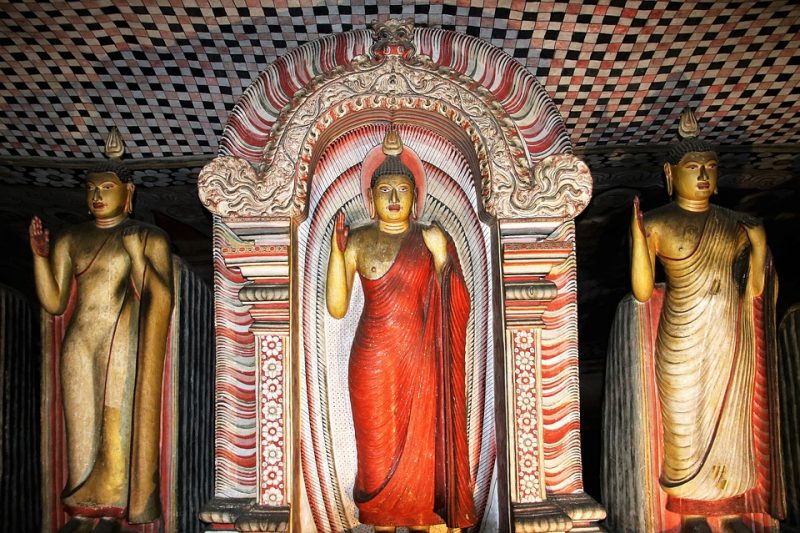PLACES TO VISIT IN DAMBULLA CAVE TEMPLE
Dambulla Cave Temple, also known as Dambulla Golden Cave Temple, is one of the most precious ancient sites on the island of Sri Lanka. This sacred temple has been a place of worship for Buddhist devotees for more than 2000 years, making it one of the oldest temples in the world. This ancient temple houses a large number of murals and sculptures that originated many thousands of years ago. Today, Dambulla Cave Temple is an important world heritage site located within the cultural triangle of Sri Lanka and included in most Sri Lanka tour itineraries.
Table of Contents
- DAMBULLA GOLDEN TEMPLE
- WHY SHOULD I VISIT DAMBULLA GOLDEN TEMPLE?
- PLACES TO VISIT IN DAMBULLA CAVE TEMPLE
- 5 BEST PLACES TO VISIT IN SRI LANKA IN ONE-DAY
- WHERE IS DAMBULLA CAVE TEMPLE?
- SRI LANKA TEMPLE DRESS CODE
- HISTORY OF THE DAMBULLA CAVE TEMPLE
- WHAT DO I SEE IN THE DAMBULLA ROCK CAVE TEMPLE?
- DAMBULLA ROCK CLIMB FROM A9 ROAD
- DAMBULLA ROCK CLIMB FOOTPATH
- DAMBULLA ROCK CLIMB FROM COLOMBO-DAMBULLA MAIN ROAD
- BREATHTAKING SCENERY FROM DAMBULLA CAVE TEMPLE
- IMPORTANT PARTS OF DAMBULLA CAVE TEMPLE
- STONE INSCRIPTION OF THE CAVE TEMPLE
- DEVARAJA LENA-FIRST CAVE OF DAMBULLA CAVE TEMPLE
- MAHARAJA LENA-SECOND CAVE OF DAMBULLA CAVE TEMPLE
- THE MURALS
- MAHA RAJA LENA: THE THIRD CAVE
- THE WALL PAINTINGS
- PACHIMA VIHARA: FOURTH CAVE
- DEVANA ALUT VIHARA: FIFTH CAVE
- HOW TO GET TO DAMBULLA CAVE TEMPLE
- HOTELS IN DAMBULLA
- ENTRANCE FEE TO THE TEMPLE
- DAMBULLA TEMPLE OPENING HOURS
- WHY VISIT DAMBULLA ROCK CAVE TEMPLE WITH SEERENDIPITY
DAMBULLA GOLDEN TEMPLE
Dambulla Golden Cave Temple of Dambulla Rock Cave Temple was providing shelter to King Walagambahu in the 1st century BC, during the troubled period in which the King lost his throne due to the South Indian invasions. Later, King regained his throne, and the king had developed the caves into an impressive Buddhist temple complex.
Scattered across Sri Lanka, from the northernmost city of Jaffna to the southern tip of Sri Lanka, Dondra, thousands of Buddhist stupas, image houses, Buddhist temples, and monasteries serve as places of worship and reminders of the principles of Buddhism.
Of these thousands of Buddhist temples, none holds the artistic and historical value of the Dambulla Golden Cave Temple; that’s why it is a UNESCO World Heritage Site. On the western side of Dambulla Mountain, the temple has a secret location that is inaccessible to outsiders.
Located on a cliffside, the temple dominates a beautiful panoramic view of the nearby lowland countryside. Visitors to the temple can witness rolling hills, lakes, patches of forests, and huge rice paddies from the temple.
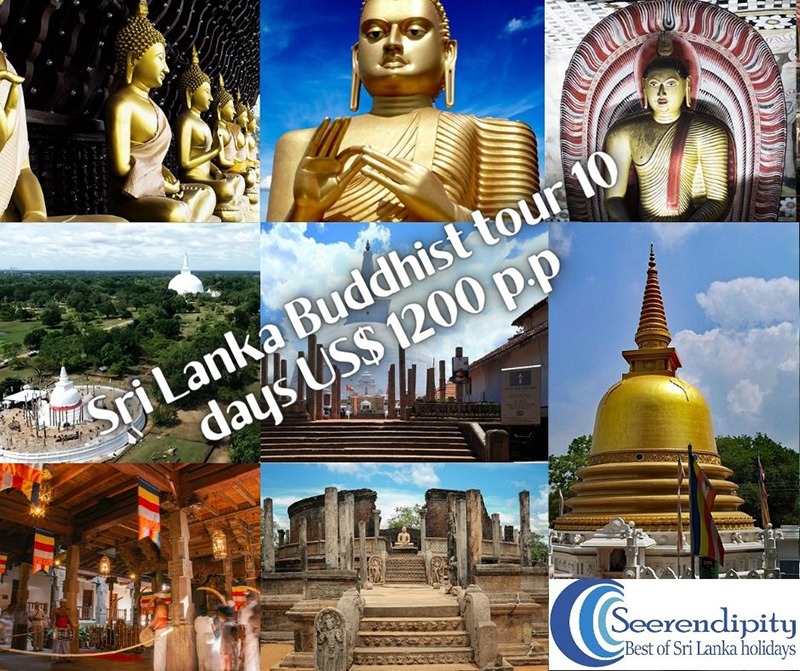
WHY SHOULD I VISIT DAMBULLA GOLDEN TEMPLE?
Many thousands of travellers are drawn to the sacred cave temple every day, and most of them are foreign travellers. There are many reasons why the Dambulla Cave Temple is so popular among travellers: The ancient cave temple is world-renowned and a UNESCO World Heritage Site. The temple features exemplary architecture (similar to Sagrada Família); there is no better place to enjoy ancient temple paintings in Sri Lanka; 90 percent of the inner wall and the ceiling of the cave temple are covered with many thousands of years of ancient paintings; it is closely associated with one of the greatest kings of Sri Lanka, Walagambahu; the cave temple is associated with an important incident (like St. Paul’s Cathedral and the royal wedding), which took place in the 1st century BC. This ancient temple is tucked away from the hustle and bustle of the city, and the cave temple is an ideal hideout to find your inner peace.
Dambulla Golden Temple is one of the most important historical monuments, and it is one of the best-preserved archaeological sites on the island. If you wish to see a typical Buddhist temple in Sri Lanka, this would be a great opportunity for you. Dambulla Cave Temple is included in most Sri Lanka holiday packages, along with Sigiriya Rock Fortress and Polonnaruwa Ancient City. Visiting Dambulla Golden Temple on a day trip from Colombo is also possible, and many local tour operators, such as Serendipity, offer one-day Sri Lanka tours to Sigiriya and Dambulla. You can also book a Dambulla, Sigiriya, and Polonnaruwa one-day tour; however, it is available from Kandy.
PLACES TO VISIT IN DAMBULLA CAVE TEMPLE
Dambulla Cave Temple, also known as Dambulla Golden Cave Temple, is one of the most precious ancient sites on the island of Sri Lanka (about Sri Lanka). This ancient temple houses a large number of murals and sculptures that originated many thousands of years ago. Today, Dambulla Cave Temple is an important world heritage site located within the cultural triangle of Sri Lanka and included in most Sri Lanka tour itineraries.
A few useful links
5 BEST PLACES TO VISIT IN SRI LANKA IN ONE-DAY
12 BEST PLACES TO VISIT IN SRI LANAK IN 2-DAY TOUR
15 BEST PLACES TO VISIT IN SRI LANAK ON A 3-DAY TOUR
PLACES TO VISIT IN SRI LANKA IN 4-DAYS
22 PLACES TO VISIT IN SRI LANAK IN 5-DAY TOUR
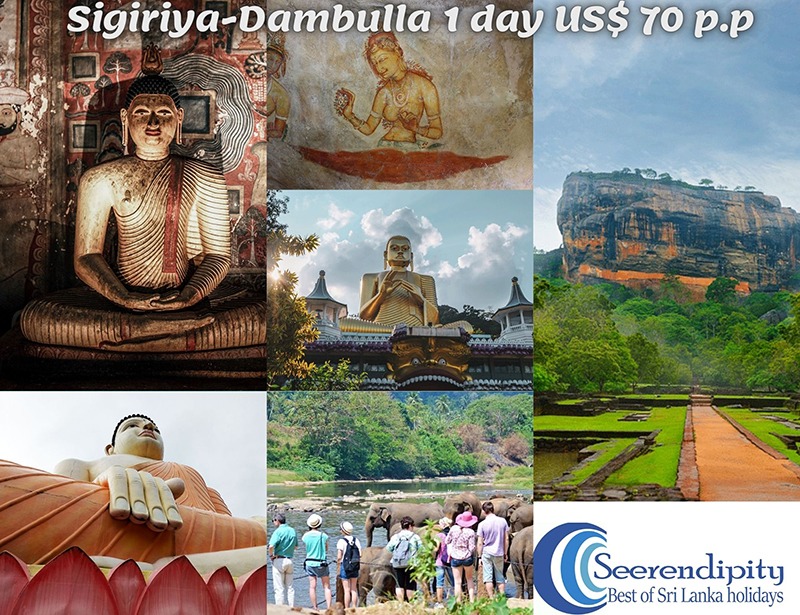
WHERE IS DAMBULLA CAVE TEMPLE?
Dambulla Cave Temple is located near the city of Dambulla, about 1 km southward from the city on the A9 main road.
The temple is fully integrated with the giant rock; therefore, the roofs, walls, and floors are practically made of stone. This cave temple is located in the city of Dambulla, in the central province of Sri Lanka. It is one of the world heritage sites in the country. Even though it takes a lot of time to reach the temple from the destinations on the west and east coasts, where the most tourist resorts are located, it is worth making a visit to the temple due to the historical and artistic value of the temple.
This temple occupies five natural caves on a giant rock near Dambulla city. A sizable number of lakes, mountains, valleys, farmlands, and swaths of forest surround the rocky outcrop where the caves are located. It was an ideal location for a peaceful Buddhist hermitage; indeed, it had been a Buddhist hermitage in the past.
SRI LANKA TEMPLE DRESS CODE
All visitors to these sacred places are supposed to dress in a particular manner to uphold their religious values. There is a set of rules that every visitor to religious sites observes while visiting sacred places in Sri Lanka. If you are wondering what these rules are, check out this article “13 RULES TO OBSERVE WHILE VISITING SRI LANKA BUDDHIST TEMPLE, SRI LANKA TEMPLE DRESS CODE TEMPLE OF THE TOOTH DRES’ CODE“.
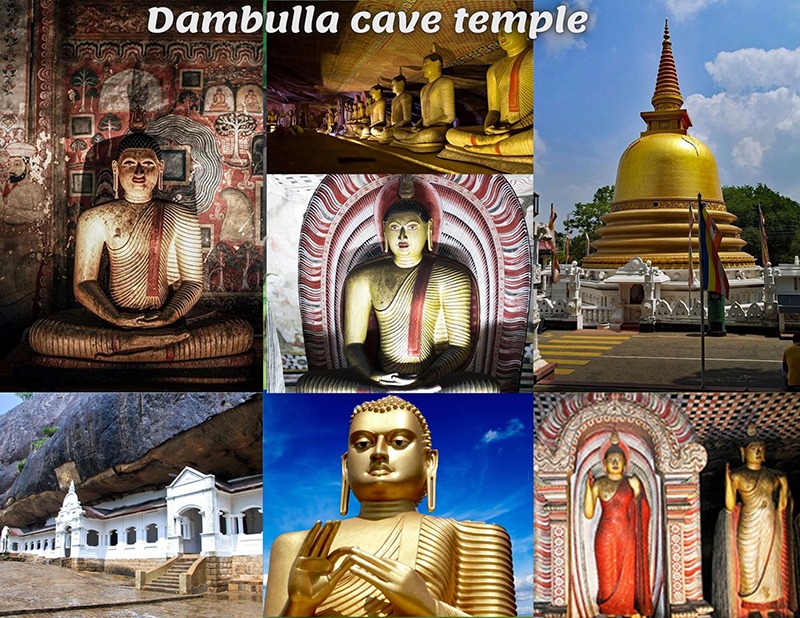
HISTORY OF THE DAMBULLA CAVE TEMPLE
Dambulla Cave Temple is comprised of five caves and is located in the city of Dambulla, Sri Lanka. This cave temple dates back to the Anuradhapura period, circa 1st century BC. Dambulla Cave Temple is one of the most visited historical attractions on the island and includes almost every Sri Lanka trip that includes the cultural triangle of Sri Lanka.
The temple was sheltering King Walagambahu in the 1st century BC, during the troubled period in which the King lost his throne due to the South Indian invasions. Later, after regaining his throne, the king developed the caves into a Buddhist temple complex. It was used as a monastery for many centuries and then neglected due to an undisclosed reason. It fell into oblivion; it was rediscovered by the British colonial rulers in 1800.
Dambulla is a fast-developing city in the north-central province of Sri Lanka. Dambulla is an important city located in the cultural triangle of Sri Lanka due to the presence of the Dambulla Golden Temple within its border.
WHAT DO I SEE IN THE DAMBULLA ROCK CAVE TEMPLE?
It has a great collection of Buddha statues representing Theravada Buddhist traditions. Dambulla Cave Temple showcases some of the masterpieces of religious paintings and sculptures in Sri Lanka. Dambulla Cave Temple is located near Sigiriya Rock Fortress, another masterpiece of ancient engineers and a UNESCOWorldd Heritage site. Dambulla Cave Temple is an important archaeological site of the cultural triangle of Sri Lanka; therefore, it is explored by visitors in conjunction with other important places in the cultural triangle such as Anuradhapura, Polonnaruwa, and Sigiriya.
The image of houses built into the rock is decorated with beautiful religious paintings. These paintings show a lot of similarities to the ancient paintings in Ajanta caves. The caves here are arranged like most Buddhist image houses, but they show a lot more charm and serenity, and the upper part of the rock also keeps the hot sun rays away from the caves and moderates the temperature inside. Despite the fact that the temple is located in a region with high humidity, the humidity remains at a very high level within caves most of the time. It has had some negative impact on the ancient wall paintings, and some of them are already partly destroyed.
The unique formation of the rock has created a gap with a sizeable space in which the image houses were built. Even though the rock is located in the dry zone of Sri Lanka, the oppressive heat is not felt here due to the constant wind. The opening of the rock is facing the western direction, and the wind blows directly into the caves, removing the warm air trapped in the caves.
There is a spacious open passage in front of the caves, allowing visitors to move freely at the site. This archaeological site is comprised of five caves. There are about 150 statues here representing Buddha, gods, and a king from the Kandyan era. The view from the caves commands awe-inspiring scenery over the surrounding paddy fields and reservoirs in the dry zone. Therefore, the temple not only allows visitors to see some of the ancient religious paintings and statues of Sri Lanka but also discover the natural beauty of the dry zone.
DAMBULLA ROCK CLIMB FROM A9 ROAD
The temple is accessible on two major highways in Sri Lanka: the A9 main road and the Dambulla-Colombo main road. Visitors who drive to the cave temple of Dambulla from Kandy should use the A9 road to access the temple. Travellers coming from Colombo can use the Dambulla-Colombo main road to quickly reach the cave temple.
DAMBULLA ROCK CLIMB FOOTPATH
There are two main paths to reach the Dambulla cave temple from the base of the mountain. The 1 trekking path starts near the A9 main road, which was the official entrance to the temple and was widely used in the past. This route is more strenuous and longer than the second route. The second route starts near the Dambulla-Colombo main road, which is the official entrance at present. Access to the Dambulla cave temple through this route is much easier than the other route and quicker too.
The travellers who wish to see the ancient temple need to climb up a rock, which is about 200 metres from the surrounding area. The temple is located on a rocky outcrop in the dry zone of the country. A giant rock cave houses the statues and paintings of the temple of Dambulla. There are several spacious caves about halfway up on the rock. These natural caves were inhabited by Buddhist monks in the early days of the Sinhalese civilization. Later, the temple was established by King Walagambahu in the 1st century BC.
The path to the temple is paved with cement steps, but it can be a bit tough due to the rapid climb. Despite the effort that demands you to pump more adrenaline than for an average rock climb, this fascinating temple is visited by hundreds of thousands of travellers every year. Travellers can enjoy elegant and artistic religious paintings and statues that originated many centuries ago.
DAMBULLA ROCK CLIMB FROM COLOMBO-DAMBULLA MAIN ROAD
The rock climb on this route is very easy and faster due to the well-built stairs. And the number of stairs to climb is about half as many as the number of stairs found on the other route. The steps are broad and wide, even though they may be a bit high. There are about 250 steps on this side of the climb, and it takes about twenty minutes to reach the end of the temple. The entrance of the temple is located after the second part of the climb, and one can have a magnificent view over the surrounding vegetation from the main door.
BREATHTAKING SCENERY FROM DAMBULLA CAVE TEMPLE
There are a number of rice fields and tanks around Dambulla rock. Dambulla Rock is located in the dry zone of Sri Lanka, and the area is covered with dry zone evergreen vegetation. Beautiful, isolated hills can also be seen from the summit of the Dambulla rock. One can see the Sigiriya rock from a distance if the weather is clear. One reaches the inscription of King Nissankamalla from Polonnaruwa at about halfway up the climb after the platform.
The Dambulla rock climb ends up in an open, flat area on the rock, and the entrance to the Dambulla cave temple follows. The giant doors of the temple stay open during visiting hours. Just after entering the temple premises, one can see the Bo tree and the caves that are lined up towards the left-hand side.
IMPORTANT PARTS OF DAMBULLA CAVE TEMPLE
- Stone inscription
- Devarahja Lena
- Maharaja Lena
- Maha Alut Viharaya
- Pachima Vihara
- Devana Alut Vihara
STONE INSCRIPTION OF THE CAVE TEMPLE
The stone inscription is located on the right-hand side after entering the temple. The inscription is carved onto the natural rock and which creates the complete picture of the temple. The inscription is written in old texts.
DEVARAJA LENA-FIRST CAVE OF DAMBULLA CAVE TEMPLE
A Brahmi inscription outside the temple to the right marks its creation. Cave 1, the Devaraja Viharaya or “Temple of the Lord of the Gods,” is named for Vishnu, who built the caverns. Most of the limited space is taken up by the 14-meter sleeping Buddha. The rock Buddha statue has slight gold plating on his elbow (usually covered). Ananda, the Buddha’s most devoted disciple, is memorialised at his feet, while Vishnu and other deities are shrouded behind a painted wooden screen. Some of the cave’s older murals have been ruined by years of painting over them. The bright frescoes behind Ananda’s head feature an odd tree with an Italian-style cherub, which are uncomfortable 20th-century decorations.
A Brahmi inscription outside the temple to the right marks its creation. Cave 1, the Devaraja Viharaya or “Temple of the Lord of the Gods,” is named for Vishnu, who built the caverns. Most of the limited space is taken up by the 14-meter sleeping Buddha. The rock Buddha statue has slight gold plating on his elbow (usually covered). Ananda, the Buddha’s most devoted disciple, is memorialised at his feet, while Vishnu and other deities are shrouded behind a painted wooden screen. Some of the cave’s older murals have been ruined by years of painting over them. The bright frescoes behind Ananda’s head feature an odd tree with an Italian-style cherub, which are uncomfortable 20th-century decorations.
MAHARAJA LENA-SECOND CAVE OF DAMBULLA CAVE TEMPLE
Being the biggest cave (60m long and 15m in height) in the temple, Maharaja-Lena houses 66 Buddha statues in various sizes. Maharaja-Lena is considered to be the most beautiful cave on this world heritage site. Buddha statues in the second cave belong to different periods and different rulers. Most of the statues had been adorned with gold during the 12th century AD. Other than the Buddha statues one can find several god figures in the second cave along with beautiful paintings that cover a large part of the inner surface of the cave.
Cave 2 in Dambulla, the Maharaja Vihara or “Temple of the Great Kings,” is the largest and most impressive. Seven metres high and almost fifty metres long, it’s a large burial place. It was built by Vattagamini Abhaya but considerably renovated and rebuilt in the sixteenth century. The cave was named after two kings’ statues found inside. Vattagamini Abhaya’s painted wooden figure is the first image, located left of the farthest door from the main entrance. Nissankamalla is hidden behind a large, reclining Buddha at the end of the cave on the right in the second photo. This most egotistical Sinhala ruler met a mysterious fate.
The cave has many Buddha carvings on its sides and back. Traces of the gold leaf covering from the main Buddha statue are to the left of the cave, beneath a makara torana in the abhaya (“Have No Fear”) mudra. Both sides have wooden Maitreya and Avalokitesvara (Natha) statues. Saman and Vishnu statues lean on the wall behind the big Buddha, while Ganesh and Kataragama paintings are on the wall beyond. The Hindu, Mahayana, and Theravada gods in such a little space are diverse.
THE MURALS
Cave 2 has the best murals in Sri Lanka on its walls and roof. Kandyan-style strip panels depict Buddha’s life and Sri Lanka’s sacred dagobas on the cave’s western ceiling (left as you approach). The small white elephant, representing the Buddha’s unborn child’s features, is barely discernible. It appeared in the Buddha’s mother’s pregnancy dream. These murals pale in comparison to the three neighbouring ceiling panels that depict the Mara Parajaya (“Defeat of Mara”), which describes the Buddha’s temptations at Bodhgaya while pursuing enlightenment. In the first, he sits under a well-kept bo tree as swarms of hairy, grey devils—one with a musket—shoot arrows at him. Mara watches over everyone from an elephant. In the next panel, The Daughters of Mara, the Buddha is tempted by a large number of beautiful maidens, failing to distract his attention. The next Isipatana panel recalls the Buddha’s victory against these marvellous feminine inventions. It shows the Buddha preaching for the first time to a vast group of beautifully clothed gods.
The cave’s right corner has a wire-mesh enclosure with a pot that absorbs roof drips. Even in the severe drought, it should not dry up.
MAHA RAJA LENA: THE THIRD CAVE
Kirti Sri Rajasinha made Cave 3, the Maha Alut Viharaya (“Great New Temple”), larger. A 10-meter-high sloping ceiling gives the cavern the appearance of a big tent with over fifty seated and standing Buddhas. Kirti Sri Rajasinha’s statue and four attendants are painted on the wall behind him to the right of the entrance. The meditative Buddha in the cave’s midsection and the sleeping Buddha on the left wall are carved from solid rock, which is remarkable considering that each stone had to be chipped off with abrasive chisels.
THE WALL PAINTINGS
Cave 3 features fascinating murals. Two ceiling paintings depict Maitreya, the future Buddha, preaching in a Kandyan pavilion. He speaks to a group of stern followers (look up as you approach the cave) and to a meeting of magnificently decorated gods in the Tusita paradise, where he is thought to be until his return to Earth in five billion years. Once out, you’ll see another intriguing picture of an idealised setting with square ponds, trees, elephants, cobras, and Buddhas (behind a pair of seated Buddhas). A folkloric nineteenth-century addition to Kandyan murals
PACHIMA VIHARA: FOURTH CAVE
This is the fourth cave of the temple and houses a number of Buddha statues, one miniature Dagoba and a number of paintings. Most of the paintings are in bad condition due to the high humidity in the cave.
Even though cave 5, built later, is farther west, Cave 4, the Paccima Viharaya (or “Western Temple”), is modest. Many identical Buddhas in meditation attitude line the walls, along with a few larger images, one of which is draped and rests beneath an exquisite makara torana arch. The centre dagoba was broken into by criminals who thought Queen Somawathie, Vattagamini Abhaya’s wife, was bringing treasures. Like Cave 5, it has Buddha sculptures and floral and chevron wall decorations, most of which were refurbished in the early 1900s.
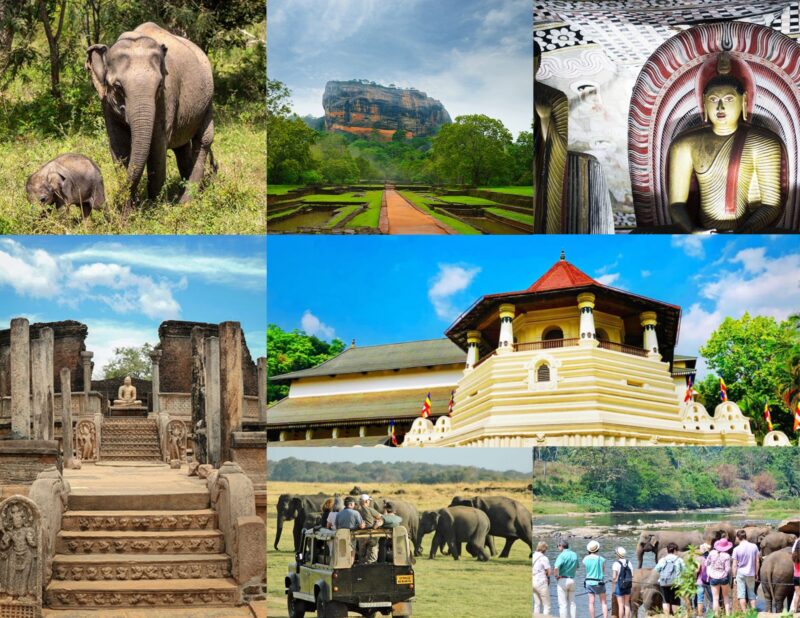
DEVANA ALUT VIHARA: FIFTH CAVE
Last cave of the temple houses a large reclining Buddha statue, along with several other statues that are in meditation and standing postures.
The Devana Alut Viharaya (“Second New Temple”) figures in cave 5 are made of brick and plaster, unlike most of the other statues at the site, which are built of rock. It’s the temple’s most modern. A 10-meter-tall reclining Buddha is the centrepiece. The wall behind his feet has paintings of a dark Vishnu with Kataragama and his peacock to the right and Bandara, a local god, to the left. The temple may have been donated by a nobleman in a painting holding lotus blossoms on your right as you leave.
HOW TO GET TO DAMBULLA CAVE TEMPLE
Dambulla cave temple is located near the city of Dambulla and the temple is only 200 meters away from the city centre. After arriving at Dambulla city the travellers need to have a short drive or a walk in the direction of Kandy on the A9 main road. The modern part of the Dambulla temple is located adjoining the main road and the historical Dambulla cave temple (world heritage site ) is located Behind the modern part of the temple. The most prominent landmark of the temple is the 30 meters high gold-coloured seated Buddha statue, which is clearly visible to the passer-by.
HOTELS IN DAMBULLA
There are several high-end hotels in Dambulla. Most hotels are concentrated around Dambulla Lake, which is the most picturesque part of Dambulla where the natural beauty is at its best. This area is very rich in trees and plants and away from the hustle-bustle of the busy city. There are several other properties in the area catering to low-budget travellers such as guest houses and rest houses.
The number of accommodation providers in Dambulla is very low compared to other popular places with a historical background such as Sigiriya. Therefore a large number of the tourist base in Sigiriya or Habarana make a short tour (30 minutes drive from Habarana to Dambulla) to the Dambulla cave temple.
ENTRANCE FEE TO THE TEMPLE
Dambulla rock cave temple entrance fees are decided by the caretakers of the ancient cave temple. The Cave temple belongs to the nearby Buddhist temple and it is not within the control of the government. The entrance fee of the Dambulla cave temple is 1500 Rs (USD 10) per person at the moment and it is valid only for 1 visit.
Dambulla Rock Cave T,emple is a historical monument with a rich historical past. The temple is comprised of a large number of statues and murals dating back many centuries. Having a local guide is the best way to learn about this world heritage site. There are many stories and folklore involved with this important religious site. If you have a guidebook on Sri Lanka, it might contain only the basic information on this temple but if you wish to know the information in detail you can hire a local guide who is ready to help you.
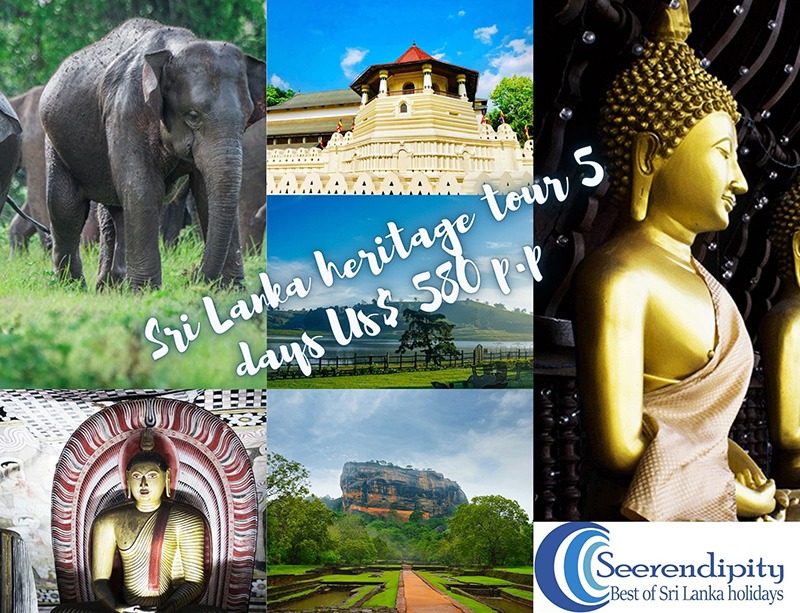
DAMBULLA TEMPLE OPENING HOURS
The temple tour lasts about 1 hour but the duration might vary depending on your interest. The Dambulla cave temple opens daily from 6.00 AM to 6.00 PM. However, the temple is closed to visitors during the pooja ceremony that takes place in the morning at noon and in the evening. usually, the temple is closed for about 15 minutes on each occasion.
WHY VISIT DAMBULLA ROCK CAVE TEMPLE WITH SEERENDIPITY
Seerendipity Tour is an entirely locally owned travel company with a head office in Colombo. The highly experienced local staff is a key strength of Seerendipity Tours, and they can plan your dream holiday to Sri Lanka.
The best price guaranteed for your Sri Lanka trip
When you book a tour with Seerendipity Tours, you directly book the tour with the local company, which means there are no middlemen and therefore you can guarantee the best price. Simply get in touch with us and let us know when you travel and what you like to see.
Plan your best Sri Lanka trip with-expert
Our staff makes a personalised programme for you, which you can change until you find the best Sri Lanka trip package for you. You can also browse our existing tour packages for inspiration (www.sirilaktours.com); all our ready-made tour packages are customizable and can be tailored to meet all your expectations. Write to us at admin@seerendipitytours.com, tel. 0094-77-440977, WhatsApp 0094-77-4440977
Please support us
We have put a lot of time and effort into compiling this blog post. Please be kind enough to leave your very own comments.

